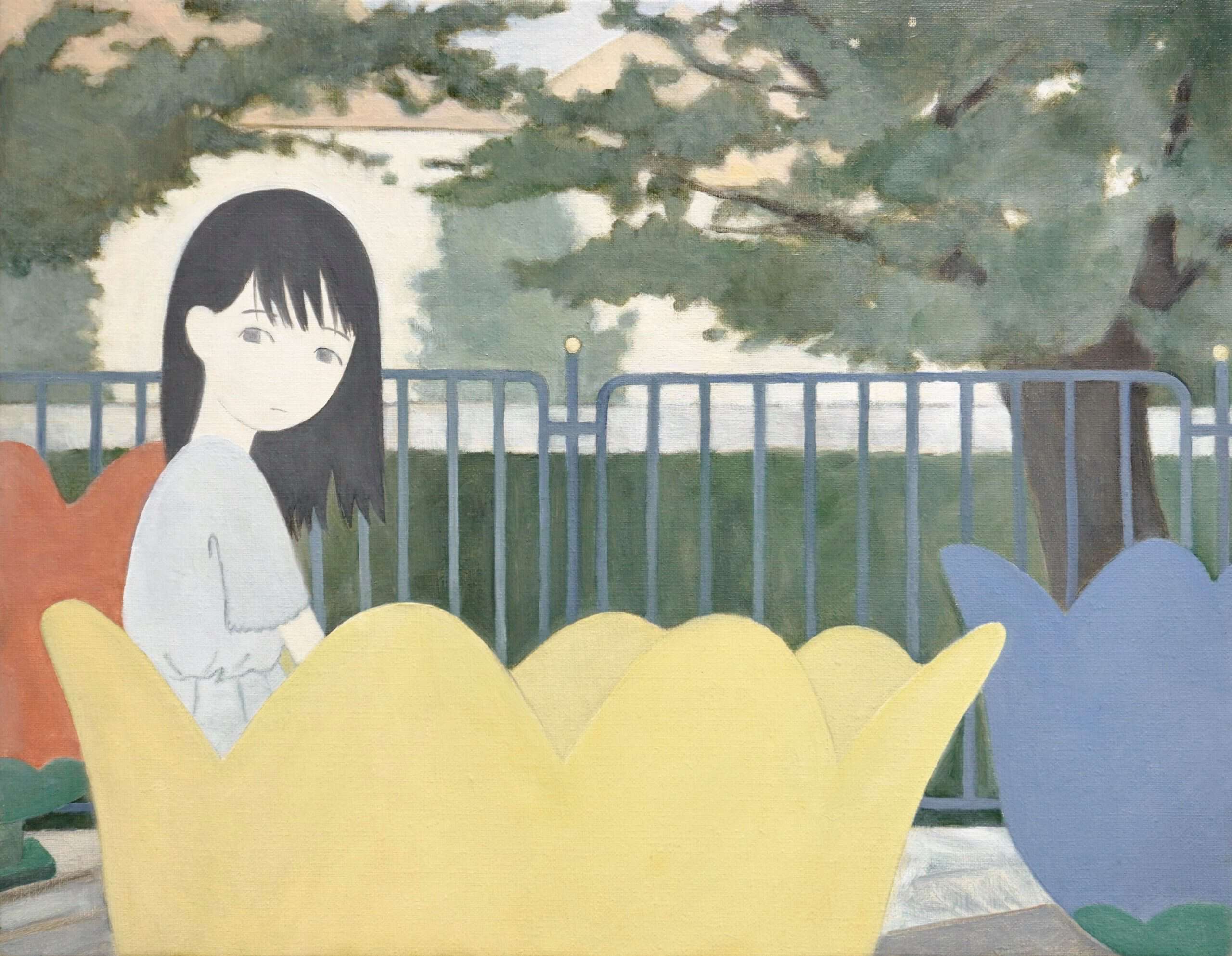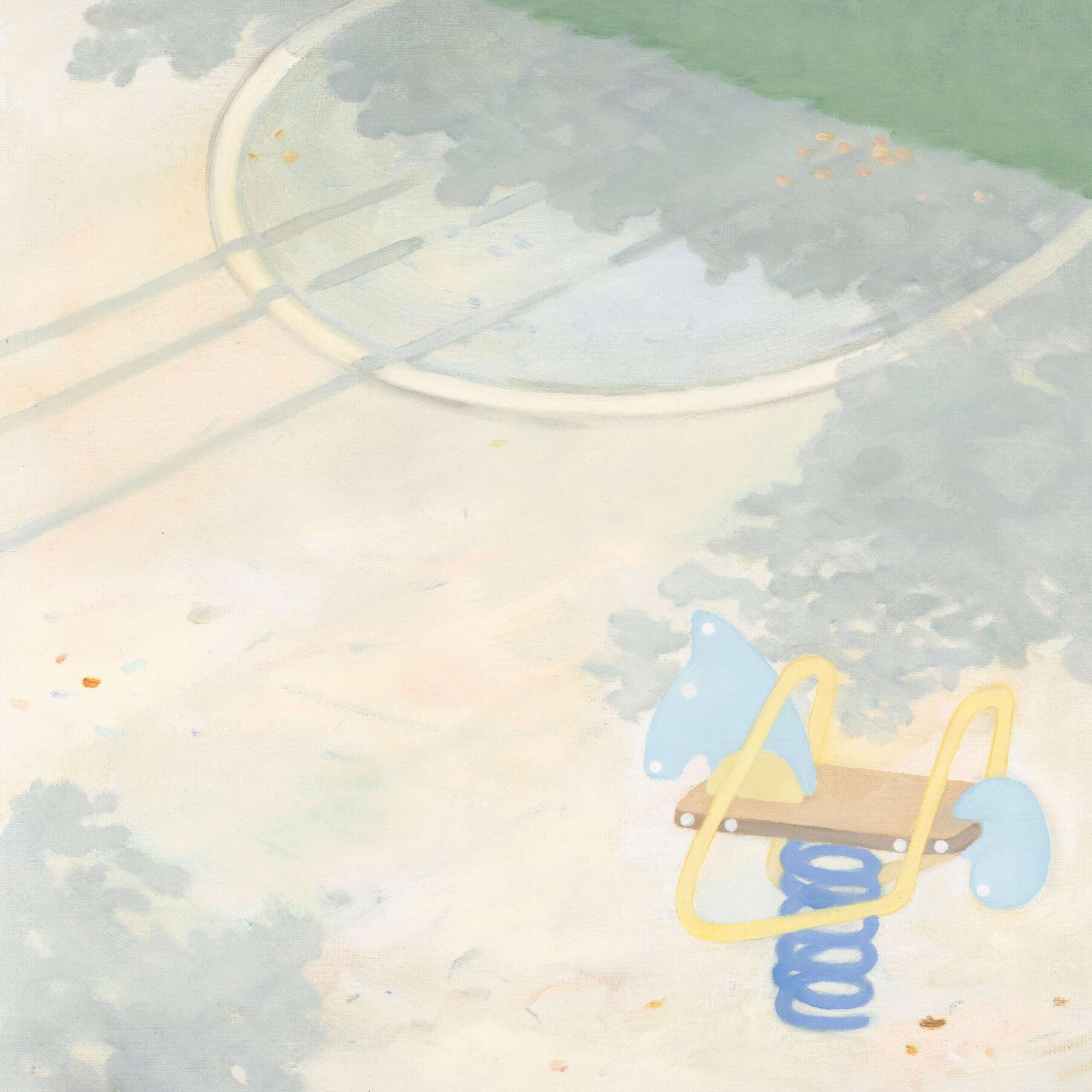Takumi Saito draws everyday scenes, such as playground equipment in the park, a corner of a room, or the side of the road, with an imaginary touch. She says, "As I grow older, I find myself repressed." She transforms landscapes and objects that evoke her childhood sensibilities and her own childhood emotions associated with them into the form of a girl and paints them on canvas. For this interview, we talked to Saito about her career and the background behind her work, which is based on her own emotional nature.
Saito-san, you mainly show paintings of girls combined with scenes that look like snapshots of daily life, but can I ask you about the background of your work, how do they relate to each other in your paintings?
Some of my paintings have girls in them and some don't, but the girls are more like emotions that connect me to my past self.
Many of the landscapes are reminiscent of my childhood. When I see something that reminds me of the past, like a landscape or an object, I usually make a note of it or take a picture of it with my camera, and that becomes the basis of my work.
WAITING ROOM, 2020, 29.7 x 42cm, Giclee printing on paper, edition:50
Click here to see Takumi Saito's works
In other words, the girl appears as a metaphor for the former Ms. Saito herself. The landscape also plays a role in reminding us of the past, but in both cases, the past is the key point.
As I grew older, I felt that I was being repressed. As I grow older, I feel that I am being repressed, and something that I used to have is drifting away, or I feel that I am losing myself. It's a very unpleasant feeling.
But the scenery and other things remind me of my old self. The scent of fallen leaves as I pedal my bicycle, or the smell of rain after it has stopped, these everyday things remind me of the past. I can't really put it into words, but I can feel the memories coming back to me. I can't really put it into words, but it feels like a memory is coming back to me, like, "This is the same as that time.
Does this repression mean that you are being held back by social interaction?
The nuance is similar...maybe. I gradually became uncomfortable with being in a group, but I found myself going along with it. Even when my friends would say things like, "Let's go home together," or "I'll meet you there," it was a little awkward. Of course, I don't mean to be offensive or anything.
For me, junior and senior high school was a blank period, and there were almost no events that I could remember. Really, there's so little that I wonder why. As you grow up, you have to deal with more and more people, restrictions, and things that you have to put up with. But I feel that if I keep fitting in, something will gradually fade away inside of me, and I feel very threatened by that. I feel like I'm losing my identity.
friend, 2020, 45.5×38cm, oil on canvas
In that sense, your work is almost like a record in a way, and not a simple depiction of a landscape or a girl.
If I wanted to leave something behind, it would be more of an emotion rather than a landscape or something that I can see. The landscapes that don't depict girls, and things like that, all work to connect me to the past, so even though I don't depict people, I want to make it look like there are still traces of them.
That's why I think people tend to think that I paint landscapes and girls, but I don't want to paint situations.
Moving on to your background, you studied Japanese-style painting, right? Did you always want to be a Japanese-style painter?
No, I was more of an illustrator first. I belonged to a manga club in junior high and high school, but I was always drawing illustrations rather than manga. I had been drawing pictures of girls for a while, but at that time it was really illustrations.
I read books with illustrations by my favorite illustrators, but I wasn't really into it. I read books with illustrations by my favorite illustrators, but I was never really into it.
From the time I was a freshman in high school, I had a vague idea that I wanted to go to an art university, and I think it was partly because I had been drawing illustrations, but I chose Japanese painting because I thought it could express two-dimensional images. I liked the flat expression rather than the lively style of the art world, and from the time I took the entrance exam, I was not very good at drawing in three dimensions. I'm also really bad at drawing.
Now you are using acrylics and oils, but I think your grammar is very different when it comes to handling materials.
When I was an undergraduate, I used Japanese painting materials, but when I used mineral pigments, I was asked to make sense of them, like "Why do you use them? But when I used Iwa-enogu, I was asked to give meaning to it, like "Why do you use it? Also, I had been drawing girls since I was an undergraduate, but I thought that if I used Japanese painting materials, my work would be perceived in the context of beauty paintings. I didn't want to go that way, and considering what I wanted to paint, I could have done it with acrylics without any problem. That's why I changed a lot of things, from painting materials to the way I painted.
In the past, I used to draw hair, faces, and other details, but I shifted to a simpler and more flat style. The drawings I used to make were close to that, and I tried to make a tableau of what I used to draw in my notebook. As a result, it was less painful for me to do that.
However, I think I have set myself some rules, or rather limits. I try not to do things that I can't do anymore. I try to keep the colors light, and in some places I use layers of colored pencils, and in other places I try to strengthen the colors in certain directions because they become too vague.

Forgetting, 2020, 31.8×41cm, oil on canvas
When did you start to bring the combination of the present landscape and the girl into your paintings?
About two years ago. I think it was around the time I finished my undergraduate degree. At that time, I added some landscapes that I had cut out of photographs, and the picture plane was a little cluttered, but I decided to set it in the time of my childhood.
I decided to set it in the time of my childhood. I want to make it more complex, or rather, I want to make it more confusing. I'm a very flat person, so I tend to be flippant. I'm trying to make it more complicated and difficult to understand. I think that makes people want to see it more than once. But lately, I think I've been drawing too much as it is.
Do you have any resistance to having a strong connection between your work and yourself?
Is it the fact that your work is so personal? I've been thinking about that a little bit before, and I still think about it now and then...
I wonder if what I'm drawing is too personal. However, I also think that there are people who draw personal things and things around them, like the Micropop artists, and also the Navi-ha artists. When I think about the kind of work I want to draw, or the kind of work that is not overwhelming to draw, I think that's the way to go. The rest is a matter of conviction, I think.
Do you like artists who draw personal things?
Yes, I do. I like artists who depict the personal, or rather the casual, using everyday objects and fragments of daily life. I like Aoki-san, who was at Watari-um the other day, Yu Nishimura, and older artists like Denis and Vuillard....
I also like Morandi. I always keep his art books nearby. I also like the Nabis school. They are very helpful in terms of themes and motifs. I also like Shizuo Aoyama, although he is not a painter. He was the biggest influence on me when I started drawing children, and I still look at him when I feel like I'm losing my way.
You have been drawing illustrations all your life, do you feel the illustration gene in your paintings?
...I don't know. I don't know. But there are times when people say, "You look like an illustration. I don't think it's that obvious, but people do say, "You're an illustrator.
But lately I think it's a bit of both. Some people call my work illustrations, others call it paintings. I've certainly been drawing illustrations for a long time, so I guess it's not surprising that I have that feeling. There are some illustrators I like and so on. So lately I've been thinking of something in between.
Somewhere between illustration and painting.
I think it's okay to have elements of both. If it has elements of both, then it's probably true in its own way.
The girl you're drawing doesn't have any facial expressions on her face.
When I'm drawing, I'm calm and collected. That's why the person I'm drawing has no expression. There's a distance there. Someone who saw my work once said to me, "Saito-san seems to have given up," and I thought that might be true. I think I've already told you the reason why there are girls or children in my work, but the reason why I draw children is more like a complex... maybe it's more like a longing. A longing to be a child.
It has a strong connection to the environment and the way I was as a child and the way I am now.
There is a sense that the person I am today and the person I was in elementary school are not connected. When I look at pictures of myself from elementary school and comments from my teachers, I feel much brighter. I thought, "Oh, so that's how it was. My environment has changed, and I have changed, and I think there are people who have always been quiet, but I have changed.

Park in the Afternoon, 2020, 33.3×33.3cm, oil on canvas
Nevertheless, the landscape or something else will trigger it to come back to life. Saito-san's paintings are a kind of resistance, a form that captures emotions in a structural way.
But it's complicated, isn't it? As I mentioned earlier, it's difficult to put into words. The feeling I get when I look at something like a landscape or an object is different from the feeling of nostalgia, and it's very difficult to explain to someone that this is what I draw.
In the end, I've come this far seriously, thinking that I'm just trying to fit in with my surroundings. I think it's natural for me to keep myself from drifting away, or to change, but I think it's sad to lose the original me. I think it is good if it remains as a form.
Profile
Born in Tokyo in 1996, graduated from Musashino Art University in 2020 with a major in Japanese painting. Major group exhibitions include "daily aw" (Koenji pocke / 2019 / Tokyo), "fog" (exhibition space CLOSET / 2020 / Tokyo), "ob curated exhibition neo wassyoi" (hidari zingaro / 2020 / Tokyo). age" (Shinjuku Ophthalmology Gallery / 2020 / Tokyo).
Click here to see Takumi Saito's works